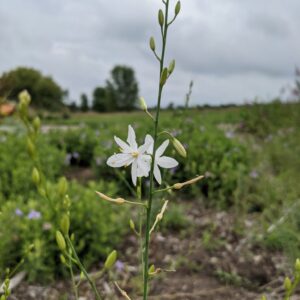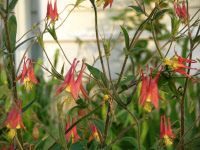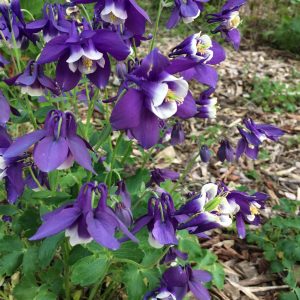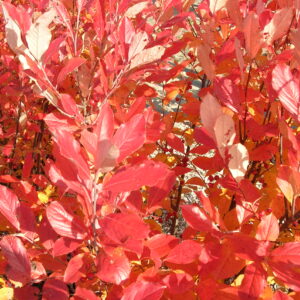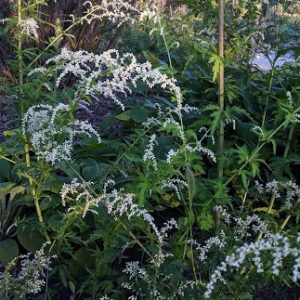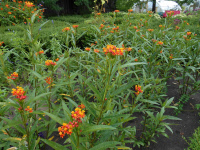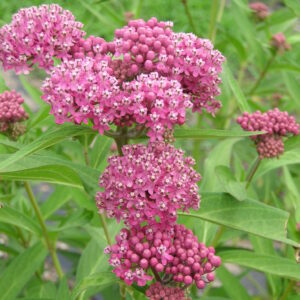Plants for Butterflies and Other Pollinators
Showing 17–24 of 223 results
-
Anthericum ramosum Spider plant, Branched St Bernard’s-lily Z 5-8
White, branched flower clusters above grass-like leaves June-August
OUT OF STOCK – EMAIL FOR AVAILABILITY
White, branched flower clusters above grass-like leaves June-August
Size: 2-3’ x 12”
Care: full sun in well-drained soil
Native: Western, Central & Southern Europe
Wildlife Value: Attracts bees, butterflies and hummingbirdsPublished by Linneaus in Species Plantarum (1753)
-
Aquilegia canadensis Canada Columbine Z 3-9
May - June scarlet and yellow columbines
May – June, scarlet and yellow columbines
Size: 24-36”x 12”
Care: part shade in moist well-drained soil
Native: Eastern Canada to Florida, west to New Mexico, Wisconsin native.
Wildlife Value: Rich, sugary nectar important food for ruby-throated hummingbirds. Buntings and finches eat the seeds. Sole food source for columbine duskywing caterpillar.Seeds are fragrant when crushed, used by Omaha, Ponca and Pawnee as perfume. Pawnee used the plant as a love charm by rubbing pulverized seeds in palm of hand and endeavoring to shake hand of desired person. Crushed seeds also used to cure fever and headaches. Cherokee made a tea for heart trouble. The Iroquois used the plant to cure poisoning and to detect people who were bewitched. Grown by Englishman Tradescant the Elder in 1632. He may have received it from France. Cultivated by Washington & Jefferson.
-
Aquilegia flabellata v. pumila syn. Aquilegia flabellata ‘Nana’, Aquilegia fauriei Dwarf Fan columbine Z 4-9
April-May lilac blooms of nodding lilac-blue to purple sepals with white petals on compact mound of blue-green foliage
OUT OF STOCK
April-May lilac blooms of nodding lilac-blue to purple sepals with white petals on compact mound of blue-green foliage
Size: 6-9” x 9-12”
Care: sun to part shade in moist well-drained soil, Deadhead for rebloom
Native: Japan
Wildlife Value: deer and rabbit resistant. Attracts butterfliesLatin word flabellatus mean fanlike referring to leaflet shape. First published as Aquilegia buergeriana var. pumila in Swiss journal Bulletin de l’Herbier Boissier 5: 1090. 1897.
-
Aronia arbutifolia Red chokeberry syn. Photinia pyrifolia SHRUB Z 5-9
Corymbs of white in spring, gorgeous red foliage in fall compliments the red berries that persist into winter
OUT OF STOCK
Corymbs of white in spring, gorgeous red foliage in fall compliments the red berries that persist into winter
Size: 6-8' X 3-5'
Care: sun to part shade in moist to well-drained acidic soil. Prune annually in late winter to promote vigorous growth.
Native: Nova Scotia west to Ontario south to TX & FL
Wildlife Value: Berries overwinter-food for Thrush, Oriole, and Cedar waxwings.Showy shrub collected by André Michaux around 1800. Aronia comes from aria a subgenus of a related plant, Sorbus. Arbutifolia means “leaves like the Arbutus.” William Robinson, father of mixed borders, reported: “Massed, charming both in flower and fine color of leaf in autumn.”
**LISTED AS OUT OF STOCK BECAUSE WE DO NOT SHIP THIS ITEM. IT IS AVAILABLE FOR PURCHASE AT OUR RETAIL LOCATION.
-
Artemisia frigida Prairie sagewort, Silky wormwood Z 3-10
Erect stems bear silvery-white, finely-divided foliage. Leaves smell like camphor. Inconspicuous yellow flowers bloom in summer.
OUT OF STOCK – EMAIL FOR AVAILABILITY
Erect stems bear silvery-white, finely-divided foliage. Leaves smell like camphor. Inconspicuous yellow flowers bloom in summer.
Size: 6-18” x 12-18”
Care: sun in well-drained soil
Native: all North America except the SE, CA and OR, Wisconsin native
Wildlife Value: deer resistant, source of nesting material for native bees, food for caterpillars of several butterflies & moths
Awards: Royal Horticultural Society Award of Garden Merit
Size: Native Americans used this Artemisia to preserve meat, feed horses, repel insects, to remedy toothache, headache, coughing, lung ailments, heartburn, and colds. Indians in Great Basin used it in ceremonies. Chippewa made a decoction of root for convulsions. For the Lakota this was "women's medicine" with an infusion helping regulate menstrual periods and inducing contractions in pregnancy.Meriwether Lewis collected this along the Missouri River in South Dakota on October 3, 1804.
-
Artemisia lactiflora White mugwort Z 3-8
Plumes of creamy white, resembling an astilbe, above foliage blackish-green on one side and silver on the other side, Blooms August to October
OUT OF STOCK – EMAIL FOR AVAILABILITY
Blooms in plumes of creamy white, resembling an astilbe, above foliage blackish green on one side and silver on the other side. Blooms August to October.
Size: 4-5’ x 1.5-2’
Care: sun to part shade in moist, well-drained soil.
Native: East asia-China
Wildlife Value: attracts butterflies & bees. Rabbit and Deer tolerant
Awards: Royal Horticultural Society Award of Garden MeritGenus is named for Artemis, Greek goddess of the moon, wild animals, and hunting. Lactiflora means “milk-white flowers”
Used in traditional Chinese medicine to treat menstrual & liver disorders, and reduce inflammation. Southeast Asians cook with its leaves and tender stems boiled or stir fried and added to soups. 1st described in Western literature 1837.
-
Asclepias curassavica Bloodflower or scarlet milkweed Z 9-11 Annual in colder areas
Small scarlet red and orange umbels all summer and early fall
Asclepias curassavica grows upright and tall with spiraling lance-shaped leaves. Blooming all summer and early fall. Showy flowers, in small scarlet red and orange umbels.
Size: 24-30” x 12-24”
Care: sun to part shade in moist well-drained soil
Native: South America
Wildlife Value: Attracts Monarch butterfliesIn gardens since 1750’s.
-
Asclepias incarnata Swamp milkweed Z 3-9
pink umbels, like an upside down ballerina’s skirt
Fragrant medium pink umbels, like an upside down ballerina’s skirt, July – September.
Size: 3’-4’ x 2-3’
Care: Sun in moist to moist well-drained soil, deer resistant
Native: North America – all states (except along the Pacific coast) & eastern half of Canada, Wisconsin native
Wildlife Value: host for Monarch caterpillars, flowers are source of nectar for several butterfliesNamed after Asclepias, a Greek god of medicine. Native American groups used Swamp milkweed – Chippewa to increase their strength & the stems made into twine; Iroquois to heal navels in babies, to increase or decrease urine and to make a person strong enough to punish witches; Meskwaki to drive out tapeworms; and Menominee used it as an ingredient in food – added to deer soup & cornmeal mush. Listed as growing in England in Miller’s Gardeners’ Dictionary, 1768. Pressed specimen in Emily Dickinson’s herbarium.

